Warrington Corporation Tramways
History
Warrington Corporation's standard gauge, electric tramway opened to the public on the 21st April 1902.
Except for a short extension to Stockton Heath — opened on the 7th July 1905 — and various track doublings, the tramway essentially remained 'as built' for its entire lifetime. The system totalled 6.84 miles, comprising lines: northeastwards along Manchester Rd to the Cemetery; southeastwards to Latchford; southwards to Stockton Heath, westwards to Sankey Bridges; and northwards to Longford. The latter line was in essence speculative, the corporation expecting the South Lancashire Tramways Company to build a line southwards from Lowton St Mary's to connect with it at Longford Bridge; in the event, the SLTCo line never materialised, so the corporation was stuck with an unremunerative line serving a sparsely populated area.
Despite its small size, the system was notable in having one line which not only crossed a railway on the level, but also the Manchester Ship Canal by means of a swing bridge; although this was not unique, it was certainly very rare for a tramway in the British Isles. The tramway was successful financially, making a profit in every year of its existence bar one — and contributing to the rates — all whilst subsidising the loss-making Longford line, which was retained for an astonishing 29 years.
The corporation began experimenting with bus services just prior to the Great War (in 1913), though it was to be a long time before they could be made to pay their way. Despite the exigencies of the Great War — greatly reduced maintenance and severe restrictions on purchasing new vehicles or track — the tramway seems to have emerged from the conflict in reasonable condition. After the war, the corporation continued to invest in the tramway system, replacing worn-out track, ordering new tramcars and modernising the existing fleet.
Throughout the 1920s, the corporation introduced new bus services to areas unserved by the tramway, successfully reached an accommodation with the local bus companies (Lancashire United Tramways Ltd and Crossville Motor Services), and by the close of the decade, had succeeded in creating a thriving bus operation.
The success of the buses inevitably meant that when significant expenditure was required for tramway track replacement, a comparison would be made between renewal and abandonment (in favour of buses). In January 1931, the corporation, faced with replacing the life-expired track on the Stockton line, chose to close it, along with the loss-making Longford line; the former closed on the 17th September 1931, and the latter on the last day of the same year.
The corporation was however happy to continue operating the trams until such time as wholesale track renewal was required, slowly increasing the bus fleet through revenue as opposed to loans. The Sankey Bridge and Cemetery lines closed on the 27th March 1935, with the last tram of all running on the 28th August 1935 (on the Latchford line).
Prior to this — in April 1935 — the name of the department was changed to Warrington Corporation Transport to reflect the new bus-dominated enterprise.
Uniforms
Photographs depicting tramcar crews in the early years of operation are scarce, and those that do exist almost always show staff wearing long, double-breasted greatcoats. A couple of photographs taken between 1902 and 1904 have however survived, and these clearly show that 'lancer-style' tunics were worn underneath the greatcoats; they had five pairs of buttons (narrowing from top to bottom, and bearing the full system title and coat of arms — see link) and upright collars; the latter probably bore insignia, though exactly what remains unclear. Caps were in a kepi style and bore script-lettering grade badges — Conductor was certainly used, and more than likely Motorman, though the latter cannot as yet be proven photographically — above which a small municipal coat of arms badge was worn. All badges were presumably brass to match the buttons.
By 1904, a switch had been made to military-style caps with tensioned crowns (tops); these continued to carry the same cap badges as previously, but with the relative position of the municipal shield badge and the script-lettering grade badge seemingly down to individual preference. By the mid 1920s, most staff appear to have dispensed with the script-lettering grade badges, simply wearing an employee number on their caps. Photographs taken in the 1920s also clearly show that the upright collars of the 'lancer-style' tunics bore a standard municipal arms badge on the bearer's left-hand side, and system initials — 'W C T' — on the right, all almost certainly brass. It seems reasonably likely that this collar badge arrangement stemmed from the earliest years of the system, though photographic evidence remains elusive.
By the end of the system (in 1935) conductors and motorman largely wore single-breasted jackets with five buttons, two breast pockets (with button closures) and upright collars; these carried the same insignia as previously. Photographs do however show that some individuals continued to wear the older 'lancer-style' tunics.
The brass buttons and brass insignia were more than likely superseded by chrome issues in the early 1930s, as chrome buttons have survived that are clearly marked 'Warrington Corporation Tramways'. A blue 'lancer-style' tunic has also survived, which bears 'Tramway' buttons and high fold-over collars (piped in red), the bearer's right-hand collar bearing system initials, rendered in red embroidered script lettering; exactly when this type of jacket was issued is unclear, though it must have been late on as the buttons are chrome.
Motormen and conductors were initially also issued with double-breasted greatcoats with five pairs of buttons; these were at some point replaced by larger greatcoats. No badges of any kind appear to have been worn on these garments.
Inspectors wore single-breasted jackets edged in a finer material than the main body of the jacket, with hidden buttons (or more likely a hook a eye affair) and upright collars; the latter appear to have carried embroidered 'W C T' initials on the left-hand side and Inspector, in script-lettering, on the right-hand side. The jackets also bore epaulettes (at least in later years). Caps were probably in a kepi style originally, but were eventually changed to a military pattern with tensioned crown; the latter style carried the same Warrington Corporation municipal arms badge that tramcar staff initially wore on their caps. Warrington also had a chief inspector (see below), who wore a similar uniform to the inspectors, though presumably with different collar insignia.
In common with many UK tramway systems, female staff were employed during the Great War to replace male staff lost to the armed services. Unfortunately, the sole surviving photograph shows a group of ladies in informal attire — apart from their bonnets — suggesting that uniforms had not yet been obtained at the time the photograph was taken. It seems highly likely that uniforms were eventually issued, but until photographic evidence comes to light, their precise form remains unknown.
Further reading
For a history of Warrington's tramway system, see: 'Warrington Trams and Buses' by John P Robinson; Cheshire Libraries and Museums (1987).
Images
Motormen and conductors
An inspector (possibly), a conductor and a motorman with an almost new Tramcar No 4 at the Latchford terminus, dating the photo to 1902. All present are wearing kepi-style caps. Photo courtesy of Duncan Holden.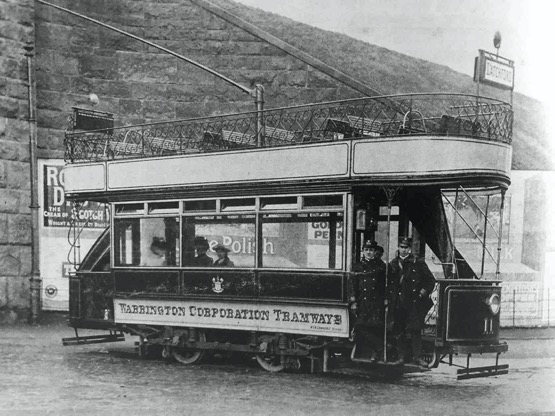
Another photo taken at the Latchford terminus, this time of Tramcar No 11 — photo undated, but given the condition of the vehicle, probably taken when relatively new, so in late 1902 or early 1903. Photo courtesy of the Jamie Steve Pickering Collection.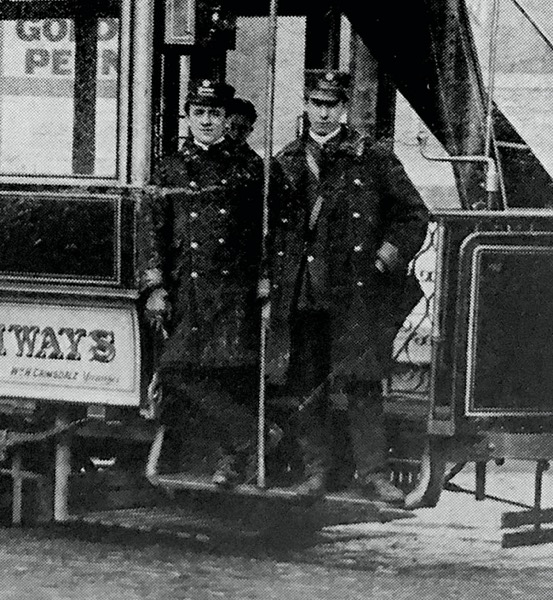
A blow-up of the above photo showing the conductor and motorman, both of whom are wearing double-breasted greatcoats along with kepi-style caps. The conductor is clearly wearing a jacket with upright collars, which from the position of the one visible button seems to be a double-breasted 'lancer-style' tunic. The caps bear script-lettering grade badges — definitely Conductor and possibly Motorman, though it could be Driver — along with a small municipal arms badge.
Standard ‘off the shelf’ script-lettering cap badges of the type used by the WCT up until the mid 1920s — brass. Author's Collection.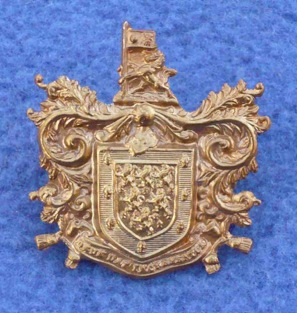
Warrington Corporation Tramways cap and collar badge — gilt. This was worn as a collar badge throughout the tramway's existence, but was superseded as a cap badge at some point, certainly by the 1920s, and possibly much earlier, by an employee number. Author's Collection.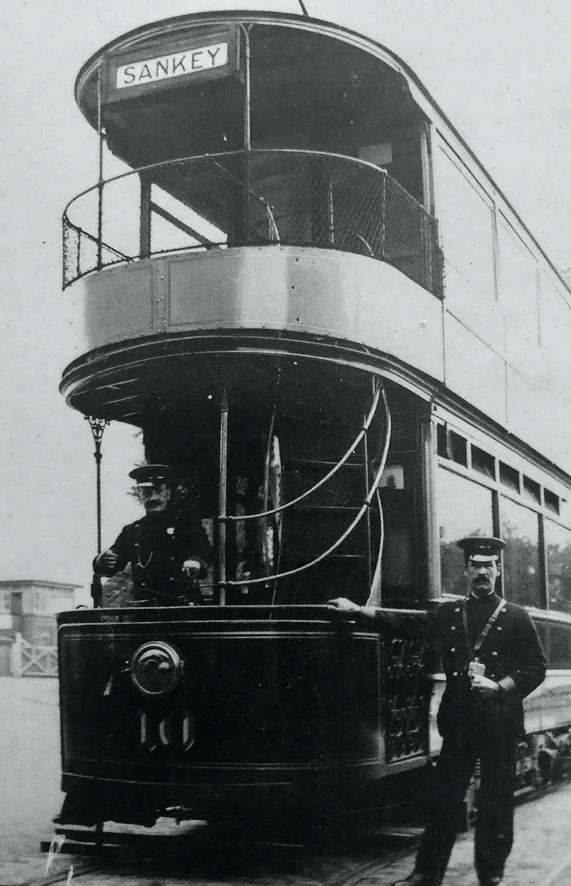
Motorman Ted Kenwright and his conductor with Tramcar No 10 at Latchford — photo thought to have been taken in 1904. Both men are wearing 'lancer-style' tunics and military style caps, the latter having presumably superseded the kepi-style caps by this time. Unfortunately, other than the conductor's script-lettering grade badge (Conductor), none of the cap or collar insignia can be made out. Photo courtesy of the Jamie Steve Pickering Collection.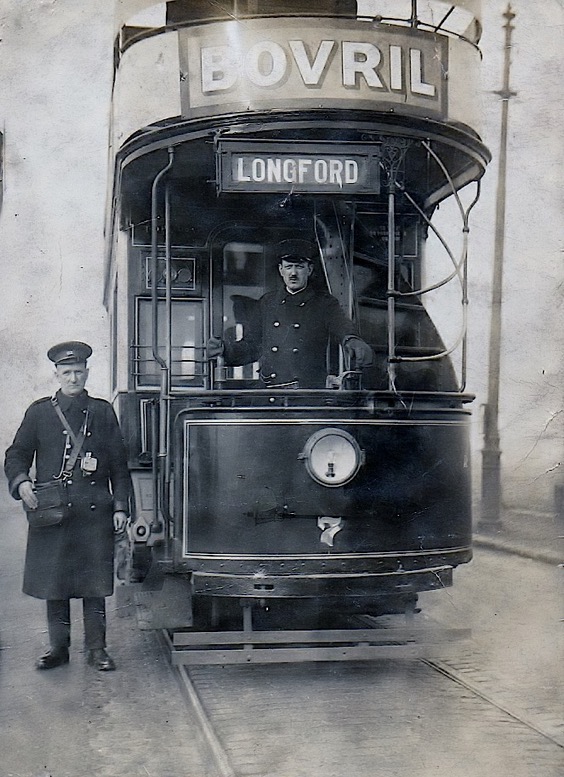
A conductor and a motorman pose for the camera with Tramcar No 7 at the Longford terminus — photo undated, but probably taken in the 1920s. Both men are wearing employee numbers on their caps. Photo courtesy of Stephen Howarth.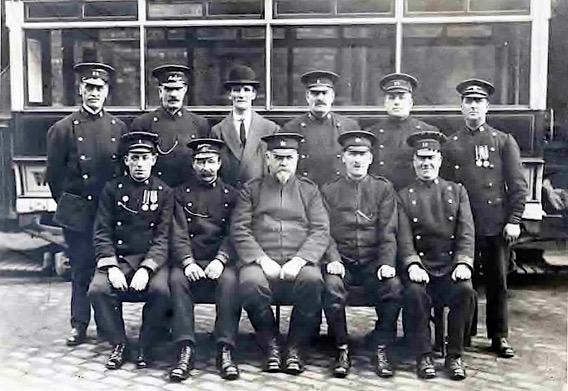
A photo of long-serving Warrington staff taken in 1927, with Chief Inspector Quinn seated centre. Three of the staff are wearing script-lettering Motorman cap badges. Photo courtesy of Stephen Howarth.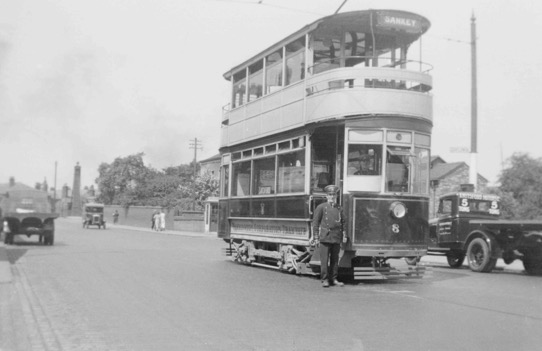
Tramcar No 8 and its motorman captured for posterity by the camera of M J O'Connor at Sankey Bridges on 5th July 1933. Photo courtesy of the National Tramway Museum. 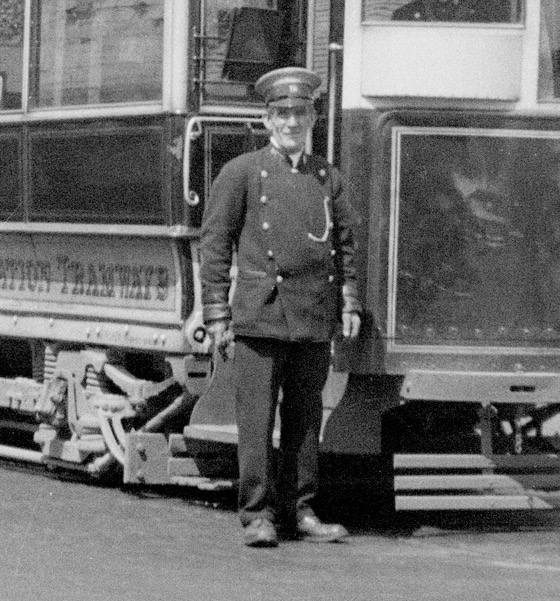
A blow-up of the above photo showing the motorman. His left-hand collar bears a small municipal arms badge, whilst the right-hand side has individual 'W C T' initials. The cap badge is actually an employee number. 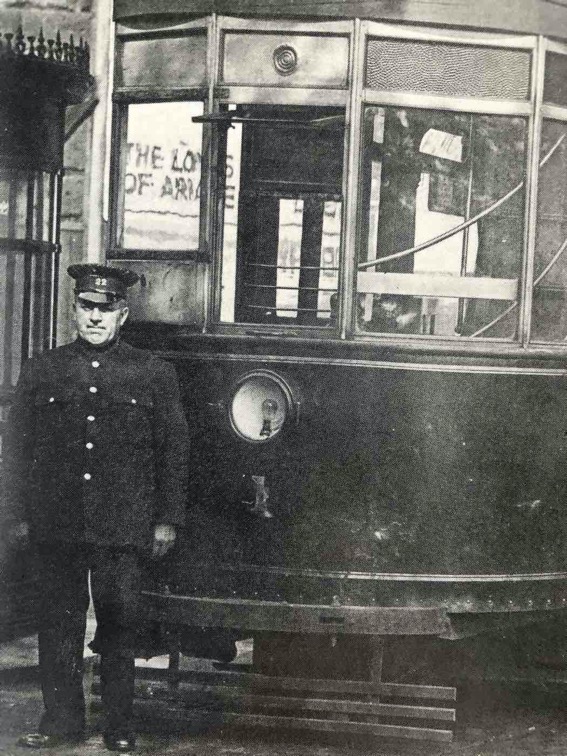
Motorman S Smith (Employee No 22) stands with Tramcar No 1 in August 1935. Photo courtesy of the Jamie Steve Pickering Collection.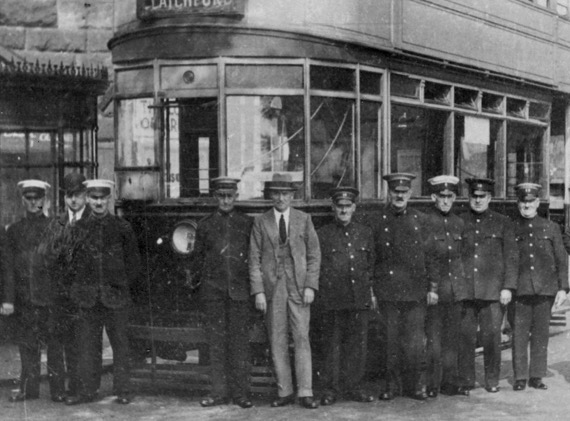
A rather careworn Tramcar No 1 stands with an array of staff at the Latchford terminus — photo undated, but probably taken in 1935, either at or shortly before closure. Photo courtesy of Duncan Holden.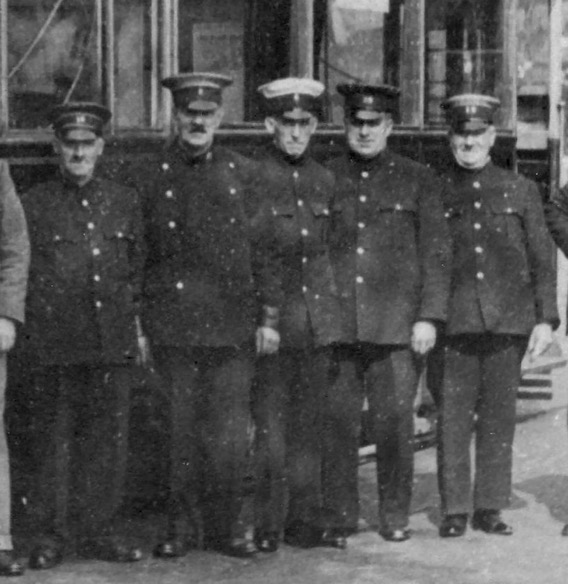
A blow-up of the above photo, showing five tramcar crew, all with employee numbers (only) on their caps.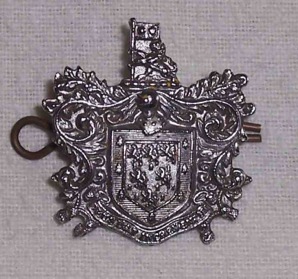
Warrington Corporation Tramways collar badge — chrome. Possibly worn from the early 1930s until closure in 1935. Author's Collection.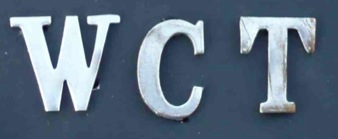
Warrington Corporation Tramways collar initials — chrome. Possibly worn from the early 1930s until closure in 1935. Author's Collection.
Senior staff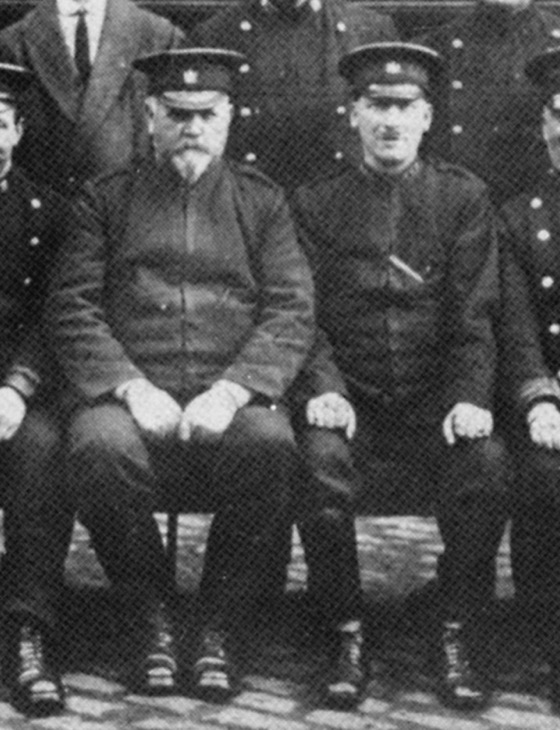
A blow-up of the long-service photo above showing Chief Inspector Quinn and another inspector to his left. Both are wearing standard Warrington municipal coat of arms badges on their caps.
Female staff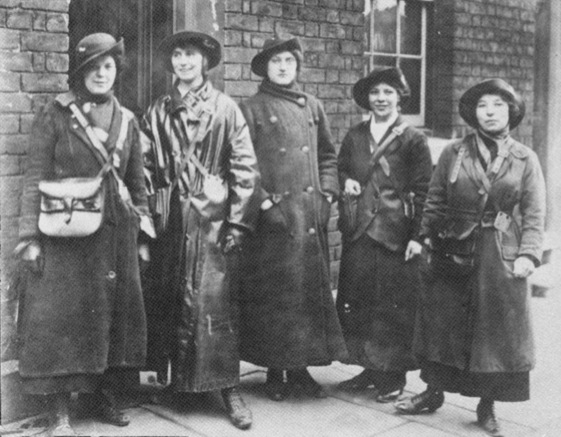
A group of Warrington Corporation Tramways conductresses — photo undated, but almost certainly taken during the Great War. With the exception of the hats, all present appear to be wearing a rather motley assortment of attire, suggesting that uniforms had yet to be issued. Photo courtesy of the Tramways and Light Railway Society.